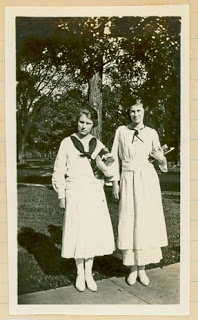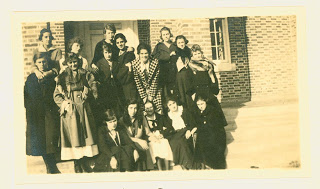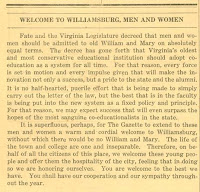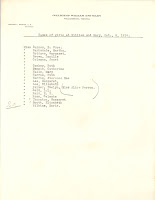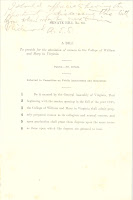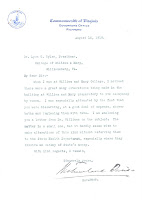Janet Coleman Kimbrough, Williamsburg resident as well as a member of the College's first class of women, later detailed a number of physcial and social adjustments that occured throughout the town:
We had daylight savings [time]; of course we'd never had [it] before. Automobile traffic was just really getting under way, and the army stimulated that tremendously. There were these military trucks continually coming through town carrying loads of military materials down to the ports and the army camps here. They tore up the road. We had no paved roads, you see, and we had two very bad winters, and they tore up the roads terribly and turned them into just almost an impossible morass -- especially the eastern end of Duke of Gloucester Street. You really couldn't get across it. You had to walk sometimes three or four blocks up the street before you could go from one side to another because of this deep mud. I remember stepping in and losing my shoe in it; there was no hope of finding it; it was way down in the mud. To complicate matters still further, the town decided to put in water and sewage -- or had decided just ahead of all this -- and they dug the street up to put in sewer pipes, and that made it that much worse. They began the thing thinking they were going to be able to finish it quickly and then because of the shortage of materials and shortage of labor and so forth, it didn't get finished as quickly as they thought. The result was that the streets were terribly torn up. Of course, the fact that almost every family had some member involved in the armed forces -- there was just so much change at that time that coeducation was a minor matter. Girls' skirts were going up; of course, the flapper and jazz and the type of dancing -- everything was "upsetting the morals and the morality of the young people," and we were coming in for a great deal of criticism. Just everything was changing; the coeducation was just one small item, really.
The above oral history excerpts are from interviews with Emily Williams, as part of an oral history project of the College conducted between 1974 and 1976. A longer excerpt of Kimbrough's interview may be found online. Catherine Dennis' scrapbook is available in the Special Collections Research Center. Taps, a booklet commemorating the Students' Army Training Corps, is available for viewing online.
